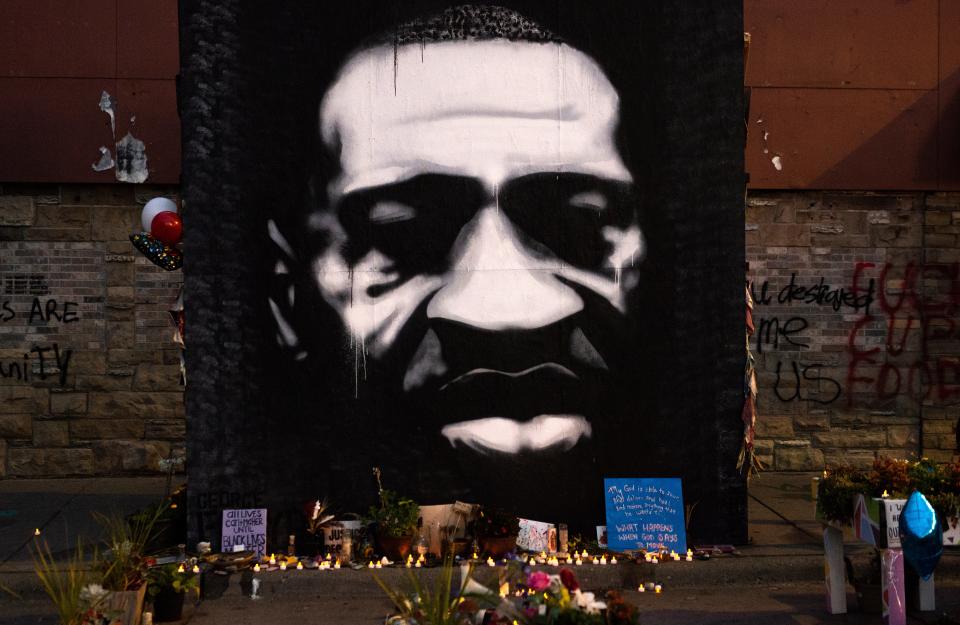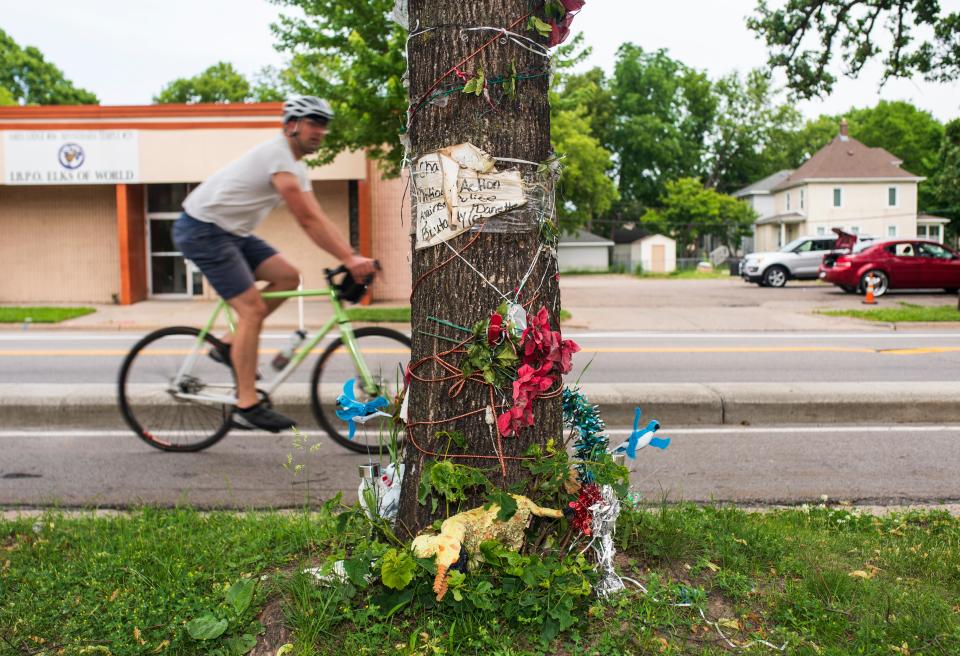What will happen to the George Floyd memorial – and all the others of Black men killed by Minneapolis police?

People come. Each and every day.
Many bring flowers or a card – some words they have jotted down. Others just walk in quiet across the intersection, stopping to take a photograph of the striking mural, or of the memorial in the shape of a fist. Few leave here unmoved.
Yet, as the city of Minneapolis takes a breath after the conviction of Derek Chauvin, the policeman who murdered George Floyd with his knee a year ago, and ponders three more potential trials, there is uncertainty over what will happen not only to the flowers and handwritten prayers, but to what has become known as George Floyd Square.
The intersection of 38th Street and Chicago Avenue in the Powderhorn Park neighbourhood has been closed to vehicles and only lightly policed since Floyd’s killing on 25 May last year, with community members and activists having erected barricades and assuming oversight. There’s grilled food to be bought, speeches to be listened to, and even a section of portable lavatories located on the edge of a fuel station, damaged in protests after his death and yet to be reopened.
The activists say they will not leave what they consider to be an active protest, until a full two-dozen demands, many of them relating to criminal justice reform, are met. Top of the list is a call to oust Mike Freeman, the district attorney of Hennepin County, which includes much of Minneapolis, and who has long been accused of failing to take action against police officers accused of killing people of colour. He denies such assertions.
The city’s mayor, Jacob Frey, and the police chief, Medaria Arradondo, want to reopen the intersection to traffic, claiming businesses and residents have complained about crimes that have taken place in the streets in the last 12 months.
“It is also true that neighbours surrounding that intersection have been subjected to far too much crime and violence over the last seven or eight months,” Frey said at a press conference last month, the day Chauvin was found guilty of second-degree unintentional murder, third-degree murder and second-degree manslaughter.
“There will be a reopening of the intersection, but it is not a going back to normal.”
Tragically, the debate that is taking place over what should happen at George Floyd Square reverberates in many other locations in the city. Less than two weeks before the jury in Chauvin’s trial delivered its verdict, another unarmed African American man, Daunte Wright, was fatally shot by police from Brooklyn Center, 10 miles to the north. A memorial has rapidly grown there, a site both of remembrance, and of outpourings of anger that such incidents are so common.
Elsewhere across the Twin Cities, there are other, smaller memorials, some aged by rain and snow and sunshine, for people whose deaths at the hands of various Minnesota police forces may have not secured global attention, but nevertheless tore apart families and communities – Jamar Clark, Philando Castile, Justin Teigen. What is to become of them, not only in the immediate years, when they are tended and maintained by family members still raw with loss, but in the future?

Are they destined to become landmarks in the struggle for racial justice, akin to the sign in Montgomery, Alabama, celebrating where Rosa Parks was arrested in 1955 after refusing to give up seat on a city bus, and triggering Rev Martin Luther King’s bus boycott demonstration?
In George Floyd Square, so many people from across the world leave flowers or other tokens, that volunteers have taken to housing them in the Chicago Fire Arts gallery, in conjunction with the George Floyd Global Memorial, established in the days after his killing.
“This is an active space, an activity protest,” says volunteer Jenny Jones, who says they have gathered more than 2,500 items left by people. “Everything is saved. Nothing is thrown away.”
In addition to letters to Floyd himself and his family, she says, people will leave prayers for people they have lost in their own lives. “One of the things about this memorial, is it’s really a public expression of grief.”
In Brooklyn Center, there are at least three memorials close to the junction of 63rd Ave and Katherine Drive. One marks the spot where Daunte Wright was pulled over in a traffic stop, and then shot by a police officer after running away and getting back into his car, the officer allegedly mistaking her Taser for her handgun. A second indicates the point, 100 yards away where his white 2011 Buick LaCrosse continued and then struck another vehicle, and where he would be pronounced dead.
Several days after Wright was killed, The Independent watched as people marked off with flowers a third location – where his body had lain on the opposite sidewalk apparently after being placed there by police. The memorial was set up after a man paying his respects, who identified himself as a Native American, said indigenous people believed the spirit remained for four days at a place where a person had died. After they marked the spot with flowers, the man lit sage.
The concrete wall into which the young man’s car came to rest is at the bottom of Shianne Williams’s garden. The 31-year-old was not at home when it happened, but says she expected the memorial would now become permanent. How does she feel about being one of its de facto curators?
“I will honour it. I think everyone does,” she says. “It’s part of my home now.”
Jamar Clark was shot and killed on Plymouth Ave N in Minneapolis in the early hours of 15 November, 2015, after police were called to a domestic dispute.
Police claimed the 24-year-old was shot after he tried to grab an officer’s gun, something disputed by his family and a number of witnesses, who said they saw the young man handcuffed and lying face down when he was killed. Hennepin County’s Mike Freeman declined to bring charges against two officers involved in the arrest. The US Justice Department also decided against charges, saying it found “insufficient evidence” for criminal civil rights indictments.
In response, protesters surrounded the Minneapolis Police Department 4th precinct for 18 days. In 2019, the city paid just $200,000 to settle a claim from his family – a fraction it paid to the family of George Floyd.
Lisa Hoskins was at home near by on the night the young man was killed, and she and her parter looked out of their apartment to see what was happening. The 37-year-old, who has a teenage daughter, says some police paid little attention to how they acted.
“I think some of them don’t care about other people’s lives,” she says. “There are some good ones, but also some bad, and you don’t know who is good.”
Toshira Garraway heads a group called Families Supporting Families Against Police Violence, that seeks to draw attention to lower profile victims of police violence in the the state.
She says Justin Teigen, her fiance and the father of a now-15-year-old son, was killed by police in 2009 in the city of St Pauls, and his body thrown in a dumpster. She said no action was ever taken. The city’s police department has always denied it was involved. St Paul police spokesperson Steve Linders told the media this year that Teigen died while fleeing from officers.
The Star Tribune newspaper has a database of every police-involved killing in Minnesota since 2000. The total stands at 207, with 43 per cent of the victims people of colour, even though they constitute just 18 per cent of the population.
Garraway says there are “hundreds of cases” the police want to push under the rug. She says a number of activists only want to get involved in the higher-profile cases in order to secure publicity.
“They don’t care about the rest of these families,” she says, adding there needs to be an independent investigation.
In George Floyd Square there is intense debate about not only what should happen to the memorial, but who should make the decision.
The Star Tribune reported that a survey of residents and business-owners found 41 per cent wanted to keep the raised-fist sculpture, created by Jordan Powell Karis, in the centre of a roundabout. Meanwhile, 40 per cent backed moving it to the northeast corner of 38th and Chicago, where Floyd lost his life.
One business owner, Sam Willis Jr, of Just Turkey, told CBS News he supported reopening the road, saying: “It’s been an economic strain on our businesses.” At the same time, while the survey was sent to 4,000 homes and businesses, only 700 were returned.

Another high-profile voice in favour of moving the memorial and permitting traffic to open again, are the four brothers who own Cup Food. It was a then 18-year-old employee of the store, Christopher Martin, who called the police after Floyd allegedly tried to use a counterfeit $20 bill.
At Chauvin’s trial, Martin testified he felt “disbelief and guilt” over what happened. “If I would have just not taken the bill, this could have been avoided.“
Since the murder, the store has received numerous threats. One of the brothers, Ahmad Abumayyaleh, tells The Independent it is vital the road be opened for traffic.
He says there should be a “huge, huge” memorial to Floyd, but suggests there is a safety risk by not permitting traffic. “The streets have to be open. Not opening the road, should not be an option.”
In a statement, the city of Minneapolis says it remained “committed to reconnecting 38th and Chicago now that the Chauvin trial has concluded to improve public safety in the neighbourhood and ensure delivery of critical services for the immediate area, including much needed public transit”.
It adds: “We are working to accomplish multiple objectives: reopening the intersection to support the needs of struggling businesses and residents, as well as preserving it as a sacred space for racial healing.”
It says it is also supporting a community backed initiative, the 38th Street THRIVE Strategic Development Plan, that sought to continue the “legacy and heritage of a deeply rooted African American community by preserving their economic vibrancy, creative identity and affordability”.
Christina Greer is a professor of political science at Fordham University in New York.
She says it is possible memorials to people such as George Floyd, and Michael Brown, who was shot and killed in Ferguson, Missouri, in 2014, will become established landmarks of this age’s struggle for racial justice.
“What's really sad, and what Black people have been saying for decades, is that for every George Floyd, we know of at least 10 other people who just never made it into the newspapers,” she says. “So he represents so many nameless people killed at the hands of the police.”
She added: “It reminds me of when Rodney King was beaten and that video came out, and you had so many Black communities across the United States, saying ‘See - we told you we weren't crazy. We weren't lying when we told you how we've been terrorised by the police’.”

 Yahoo Finance
Yahoo Finance 